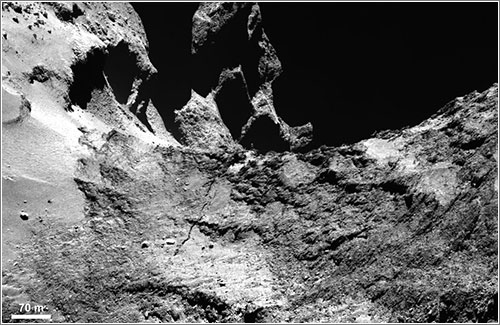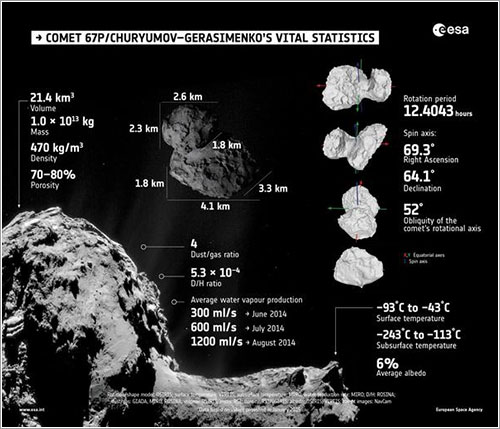
Grieta en Anuket -
Aunque la Agencia Espacial Europea venía publicando con regularidad imágenes de 67P/Churyumov-Gerasimenko, el cometa alrededor del que está en órbita la sonda Rosetta, estas provenían de la cámara de navegación de la sonda.
Pero, al fin, han publicado unas cuantas imágenes de OSIRIS, la cámara de alta resolución, a las que se puede acceder en Comet close-ups.
En Getting to know Rosetta’s comet han publicado también unos cuantos datos más acerca de 67P, ahora que ya han sido publicados los primeros artículos en Science.
El resumen:
El lóbulo pequeño de 67P mide 2,6×2,3×1,8 km, mientras que el grande mide 4,1×3,3×1,8 km, lo que da al cometa un volumen total de 21,4 km3. Las mediciones le dan una masa de 10.000 millones de toneladas, lo que le da una densidad de 470 kg por metro cúbico.
Asumiendo que el núcleo de 67P esté compuesto por hielo de agua y polvo, que tienen una densidad de unos 1.500-2.000 kilos por metro cúbico esto quiere decir que el cometa tiene una porosidad del 70 o el 80 por ciento, con la estructura interior probablemente compuesta de bloques de hielo y polvo débilmente unidos y con pequeños espacios vacíos entre ellos.

Los datos vitales de 67P - clic para ver en grande
Los científicos han dividido 67P en 19 regiones distintas, que han recibido sus nombres de deidades egipcias.
En estas 19 regiones hay cinco tipos de terreno: cubierto de polvo; materiales quebradizos con huecos y estructuras circulares; depresiones grandes, terrenos suaves, y superficies más firmes, similares a roca.
Buena parte del hemisferio norte está cubierto por polvo, y según 67P se va acercando al Sol el hielo que hay en él se sublima, convirtiéndose directamente en gas que forma la coma del cometa.
Estos gases parecen ser también los responsables de las «olas» que se ven en algunos lugares de la superficie, un poco como en la Tierra el viento mueve la arena en las playas.
Otros datos de 67P: su día dura 12,4 horas; su temperatura superficial va de los -93 a los -43 grados centígrafos; por debajo de la superficie la temperatura va de los -243 a los -113 grados.
El albedo, la cantidad de luz que refleja 67P, es de tan solo un 6 por ciento, lo que lo hace extremadamente oscuro; el de la Tierra, por ejemplo, es del 39 por ciento.

Albedo de la Tierra, la Luna, y 67P - no están obviamente, a la misma escala - ESA/Rosetta/MPS for OSIRIS Team MPS/UPD/LAM/IAA/RSSD/INTA/UPM/DASP/IDA & Gordan Ugarkovich (Earth); Robert Vanderbei, Princeton Univ (Moon); ESA/Rosetta/NAVCAM (67P/C-G)
OSIRIS ha conseguido fotografiar ya como un 70 u 80 por ciento de la superficie de 67P; lo que falta es porque aún no ha sido iluminado por el Sol desde que Rosetta anda por allí.
Así que aunque aún faltan imágenes por capturar también faltan muchas por ver; esperaremos con «ansiavia».
# Enlace Permanente
via Microsiervos http://ift.tt/1uE14fC
